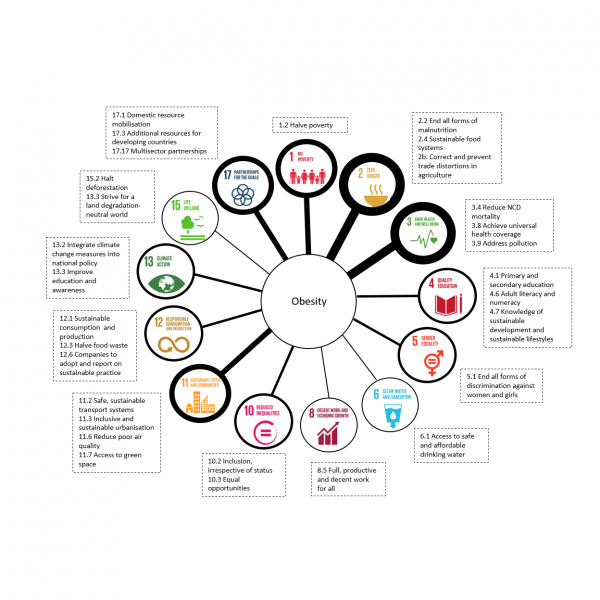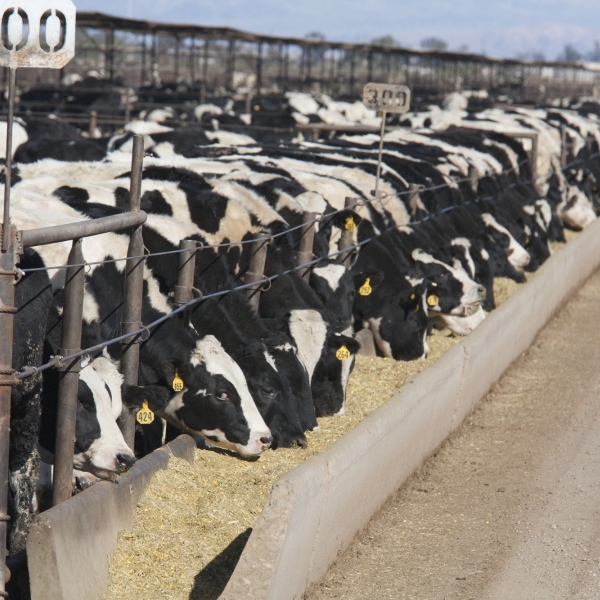Obesity and the SDGs: an opportunity hidden in plain sight
To coincide with the SDG Summit at the UN General Assembly, World Obesity’s consultant Katy Cooper highlights the many opportunities to address obesity within the Sustainable Development Goals.
Obesity within the SDGs?
The successors to the Millennium Development Goals – the Sustainable Development Goals (SDGs) – acknowledge and address the indivisibility of three aspects of development: social, economic and environmental development. The 21st century is an era of ever-greater globalisation, connectedness and shared threats – and the roadmap to enable people and planet to thrive has fundamentally altered. However, government and donor priorities often remain deeply rooted in an earlier view of development: just 1.8% of development assistance for health is allocated to non-communicable diseases (NCDs). NCDs and obesity are no longer a challenge only for high-income regions: most of the world’s population now live in countries where overweight/obesity is responsible for more deaths than underweight. And, although NCDs are the focus of an SDG target, obesity is not explicitly alluded to, making it even less likely to be the recipient of development assistance.
So, given this apparent omission, are there opportunities to leverage sustainable development to take action on obesity? The answer is yes: obesity is hidden in plain sight.[1]
This blog highlights seven areas of synergy between obesity and the SDGs; the 13 relevant Goals and accompanying targets are mapped out in Figure 1.


1. Our health
SDG3: Ensure healthy lives and promote wellbeing for all at all ages
Obesity is both an NCD in its own right and a fundamental driver of many others (e.g. type 2 diabetes). Obesity is at the heart of achieving the SDG target on NCDs:
- 3.4 By 2030, reduce by one-third premature mortality from NCDs through prevention and treatment and promote mental health and well-being
Making the connection with universal health coverage is timely, as noted in a recent World Obesity blog, because it is a current World Health Organization priority and was the subject of a High-Level Meeting of heads of state/government and health ministers at the UN General Assembly:
- 3.8 Achieve universal health coverage, including financial risk protection, access to quality essential health-care services and access to safe, effective, quality and affordable essential medicines and vaccines for all
But obesity prevention and treatment are often insufficiently prioritised within health systems, as demonstrated by World Obesity research. It is unfortunate that target 3.8 does not explicitly mention prevention, despite it being fundamental to ensuring that health systems can cope with future pressures.
2. What we eat
SDG 2: End hunger, achieve food security and improved nutrition and promote sustainable agriculture
Obesity is implied by ‘all forms of malnutrition’ in target 2.2:
- 2.2 By 2030, end all forms of malnutrition, including achieving, by 2025, the internationally agreed targets on stunting and wasting in children under 5 years of age, and address the nutritional needs of adolescent girls, pregnant and lactating women and older persons
Obesity is not restricted to high-income environments: the ‘double burden of malnutrition’ is well documented in many lower-income settings, where undernutrition and micronutrient deficiency coexist with overnutrition within the same families.
Other relevant targets are target 2.4 to ensure sustainable food production systems by 2030 (there are strong links here between climate change and health – see Box), and target 2.b, to ‘correct and prevent trade restrictions and distortions in world agricultural markets’ (which could be used to leverage the removal of subsidies on unhealthy commodities).
SDG 12: Ensure sustainable consumption and production patterns
Overconsumption of food is a burden on planetary systems and on human health. The January 2019 report of the EAT-Lancet Commission on Food, Planet, Health demonstrated the need to align consumption and sustainable agriculture, and the IPPC’s August 2019 report, Climate Change and Land, sets out opportunities for co-benefits in food production and health. But there is a long way to go before this is realised.
Climate Change
SDG 13: Take urgent action to combat climate change and its impacts
SDG13 focuses on systems change required at national level on climate change (strengthening resilience and adaptation, integrating climate change into policy), and improving education and capacity.
Climate change is – like obesity itself – a thread running throughout other SDGs, and there are targets (such as sustainable agriculture) that will have co-benefits for climate change and obesity. The January 2019 report by the Lancet Commission on Obesity, for example, set out the synergies to be found in addressing climate change in conjunction with overnutrition and undernutrition.




SDG15: Protect, restore and promote sustainable use of terrestrial ecosystems, sustainably manage forests, combat desertification, and halt and reverse land degradation and halt biodiversity loss
Target 15.2 calls for a rapid halt to deforestation – and a major driver of the razing of forests is nutrition-related: the creation of farmland for palm oil and livestock. Countries with dietary patterns that are higher in meat have been found to have higher rates of obesity and overweight.
SDG6: Ensure availability and sustainable management of water and sanitation for all
A lack of access to clean drinking water (target 6.1) may mean that in some areas the safest option is bottled drinks, including sugary beverages – as highlighted in Mexico by a recent New York Times article.
3. Our financial resources
SDG1: End poverty in all its forms everywhere
Ending poverty is core to the SDGs:
- 1.2 By 2030, reduce at least by half the proportion of men, women and children of all ages living in poverty in all its dimensions according to national definitions
Socioeconomically deprived neighbourhoods worldwide are often obesogenic, with ubiquitous unhealthy food and few opportunities for safe and healthy physical activity for all ages, coupled with a lack of understanding about nutrition or access to obesity management.
In addition, target 1.5 specifically addresses resilience to climate-related extreme events and other economic, social and environmental shocks and disasters – which will increasingly include food insecurity as climate change bites.
4. Our learning
SDG 4: Ensure inclusive and equitable quality education and promote lifelong learning
Health should be part of core curriculums and also, as the ECHO report on child obesity makes clear, health promotion should be intrinsic to the environment of schools themselves.
- 4.1 By 2030, ensure that all girls and boys complete free, equitable and quality primary and secondary education leading to relevant and effective learning outcomes
The education of girls is particularly important, as in many cultures they will be primarily responsible for the health of their children and act as the food gatekeepers for the family.
Literacy throughout life (target 4.6) includes health literacy for all ages, which is essential for reducing exposure to risk factors for obesity (such as understanding nutrition guidance and labelling), for raising awareness of treatment options – and for following sustainable lifestyles (specifically mentioned in target 4.7).
5. Where we live and work
SDG 11: Make cities and human settlements inclusive, safe, resilient and sustainable
All too often, the environment in which we live makes it challenging to lead healthy lives. Target 11.3 is a call to enhance ‘inclusive and sustainable urbanisation’. Without access to affordable, healthy food, for example, education on the importance of a good diet will be to no avail.
Physical activity is also an important driver of good health and of obesity prevention and management, and can be promoted through the targets on active travel (11.2) and on access to urban green space (11.7).
Target 3.9 addresses the need to substantially reduce death and illness from air pollution. Physical activity and active travel is safer and a more attractive option where air pollution is low and recent research indicates that higher exposure to early life near-road air pollution contributes to increased obesity risk in children.
SDG8: Promote sustained, inclusive and sustainable economic growth, full and productive employment and decent work for all
- 8.5 By 2030, achieve full and productive employment and decent work for all women and men, including for young people and persons with disabilities, and equal pay for work of equal value
This should include non-discrimination for employees with obesity, appropriate support for those with NCDs including obesity, and the fostering of a culture of health that provides all employees with a health-promoting working environment. This requirement links strongly with the SDGs on inequality (below).
6. Our equality
SDG 10: Reduce inequality within and among countries
Socioeconomic differences are linked to obesity status, as noted in the section on financial resources, above. In addition, people with obesity often suffer discrimination and stigma at work, in society and in healthcare settings – so the targets on inclusion (10.2) and on equal opportunities (10.3) should be actioned to include tackling this form of inequality.
SDG 5: Gender equity
Women with obesity are at particular risk of discrimination at work and face more complications in pregnancy. Equity demands that these risks be appropriately addressed.
7. Means of implementation
SDG 17: Strengthen the means of implementation and revitalise the Global Partnership for Sustainable Development
The 17 SDGs complement each other, taking a holistic, whole-system, intergenerational, whole-of-government and whole-of-society approach to the complex problems facing the world. Obesity is an exemplar of such an issue, the result of a dynamic system that fosters an increasingly obesogenic environment. To maximise prevention and management interventions, cross-sector collaboration with engagement from a wide range of partners – government, the private sector and civil society – is required.
There are several relevant targets under SDG 17:
- 17.1 Strengthen domestic resource mobilization, including through international support to developing countries, to improve domestic capacity for tax and other revenue collection
This could include technical assistance to establish taxation on unhealthy products (there are currently over 40 taxes on sugary in jurisdictions around the world).
- 17.3 Mobilize additional financial resources for developing countries from multiple sources
Developing countries are ill equipped to cope with the growing obesity and NCD crisis – a step-change in funding and innovation is needed to strengthen health systems.
- 17.13 Encourage and promote effective public, public-private and civil society partnerships, building on the experience and resourcing strategies of partnerships
A partnership approach is at the heart of the SDGs – and let’s shout about that, because it is also at the heart of success in tackling obesity.
In conclusion
Obesity could be a beneficiary of action taken under at least 13 of the 17 SDGs – but this significant opportunity is infrequently used to drive or fund action on this global health crisis. We should work to ensure that obesity is recognised as a sustainable development priority worldwide, including through advocating for obesity to be embedded firmly within in high-level discussions such as the SDG Summit held at the UN General Assembly on 24–25 September 2019. Tackling obesity is a prerequisite for the long-term health of people and planet.
[1] Some countries acknowledge obesity as intrinsic to the SDGs by reporting on it in Voluntary National Reviews of SDG progress e.g. Ireland includes obesity under SDG2 reporting and Turkey under SDG3. However, obesity does not yet feature in VNRs as a matter of course: this should be encouraged!